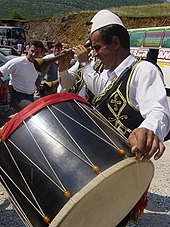Albanian dance


The Albanian dances ( Albanian Vallet shqiptare ) are an essential part of Albanian folklore and the Albanian cultural area, which extends over Albania , Kosovo , North Macedonia , Montenegro , Serbia , Greece ( Arvanites ) and Italy ( Arbëresh ).
The dances in these countries were mostly independent of each other, but they kept their common character. The performance takes place in groups, in pairs or individually.
The Albanian folk dance is very popular in the Albanian-speaking area and is cultivated at festivals, concerts and school performances and by many clubs and associations. Dancers also receive awards at festivals such as the Gjirokastra National Folklore Festival.
The dances are part of the inter-Balkan cultural area, which is why they often have similarities with the dances of other peoples in Southeast Europe .
Types

The Albanian folk dance can be divided into two basic types.
On the one hand, there are the lyrical dances, which are mainly danced by women and less by men alone. However, they are also danced together by women and men. They are divided into the following subgroups:
- Ritual dances; z. E.g. Lule manushaqe from the Kolonja region
- Wedding dances; z. E.g. Nusja jonë arbërore from the Lunxhëria region of Gjirokastra
- Erotic dances; z. Ex. Kërcimet e Logut from the Malësia e Madhe , Shkoder
- Humorous dances; z. Ex. Vallja e Nuses së Fajës from central Albania
- Pantomime dances; z. Ex. Ojna e Lepuri from Hotolisht , Librazhd
On the other hand, there are the epic dances, which are mainly danced by men and less by women. They often show traits of masculinity, bravery, strength, warlike character, pride, etc. They are divided into two subgroups:
- Martial dances; z. E.g. Loja me jatagan from the west of Kosovo
- Proud dances; this includes the many dances from southern Albania ( Toskëria )
In addition, however, there are also dances that have characteristics of both types, which are called “lyrical-epic dances” or “epic-lyrical dances”. Among the first is z. E.g. the dance Valle bishtore e Labinotit from Çermenika ( Elbasan ). The epic-lyrical dances include Ex. Kërcim burrash from the Has region of western Kosovo.
Regional differences

The dances of Toskëria , Myzeqeja , Labëria and Çamëria are accompanied by iso-polyphonic singing .
The dances of southern central Albania are often accompanied by polyphonic and homophonic singing.
The urban zones of central Albania often have vocal and instrumental accompaniment in their dances.
With Çurla and Lodra the dances east of Elbasan and Tirana up to the region of Struga accompanied.
Another difference is especially in the north of the Albanian-speaking area, where some dancers dance freely in the center of the women's dances.
Criteria for classifying dance types
On the one hand, there are criteria for the motif and the formation. To the former:
- 2/4 step
- 3/4-step
- 4/4 step
When it comes to formation, the following points must be observed in group dances:
- Dances in a closed circle ( round dances )
- Dances in a semicircle
- Dances in two parallel lines: the dancers stand in front of each other
For solo dances, criteria such as singles, couples, threes or fours apply.
Albanian national dances
Vallja e Shotës
One of the most famous dances in Kosovo is the Shota . The word “shota” ( Alb . Duck, duckling) is mostly used by Kosovars in a diminutive way for young women who are smart and pretty. This lyrical dance is performed in three variants: two women, woman-man or two men. He is accompanied vocal and instrumental.
Vallet labe të burrave
The labischen men dances are accompanied exclusively iso-polyphony. The dances are epic in character and radiate courage, pride and bravery; they are usually danced in two groups, often in a semicircle. Mostly they are led by a main dancer who performs heavy and clear dance movements.
Vallet çame
Cami dances from Epirus have lyrical and epic characteristics. They are similar to the dances of the Labëria, but there are some differences such as the very emotional and aesthetic charisma and above all the "falling down" of the main dancer - performed as a very energetic dance movement. The best known and most important example of Camino dance art is the dance of Osman Taka . This also influenced the north-west Greek ( Epirotic ) dance culture ( Tsamikos ).
Vallja Dardhare
This lyrical women's dance from the village of Dardhë in the Korça region is accompanied by vocals and danced in groups. Usually he can be found dancing in semicircles.
Pogonishtë
A South Albanian dance with 2/4 time, which is danced by men and women together. It's an epic dance. This dance has its origins in Pogon , which is located in Gjirokastra County .
literature
- Ramadan Sokoli: Albanian Folk Music . In: Werner Daum (Ed.): Albania - between cross and crescent . Pinguin Verlag, Munich / Innsbruck 1998, ISBN 3-7016-2461-5 , p. 198-202 .
Individual evidence
- ^ Vasil S. Tole: Enciklopedia e muzikës popullore shqiptare . Music Faculty of the University of the Arts Tirana , Tirana 2001 ( online ( memento of October 26, 2009 in the Internet Archive ) [accessed on February 16, 2014]). Enciklopedia e muzikës popullore shqiptare ( Memento of the original from October 26, 2009 in the Internet Archive ) Info: The archive link was automatically inserted and not yet checked. Please check the original and archive link according to the instructions and then remove this notice.